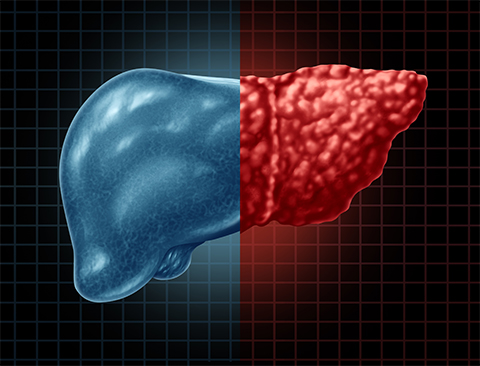From the journals: JLR
Fixation method to quantify brain metabolites. Belly fat and liver disease crosstalk. Stopping heart diseases in schizophrenic patients. Read about papers on these topics recently published in the Journal of Lipid Research.
Belly fat and liver disease crosstalk

Nonalcoholic fatty liver disease, or NAFLD, correlates with obesity as well as belly and blood fat deposition. Patients with NAFLD often progress from simple body fat deposition to free fatty acid, or FFA, accumulation in the liver, a condition called nonalcoholic steatohepatitis, or NASH. This fat imbalance disrupts the very low-density lipoprotein–triglyceride, or VLDL–TG, equilibrium in the abdomen, viscera, or organ cavity, and liver cells. In addition, obese individuals uptake more visceral and hepatic FFAs than healthy individuals. However, scientists do not understand whether obese individuals with NAFLD show different visceral and hepatic FFA and VLDL–TG levels compared to obese individuals with NASH.
Jeyanthini Risikesan from Aarhus University Hospital, Denmark, and an international team quantified FFA and VLDL–TG levels in the blood of obese patients with NAFLD or NASH. They published their work in the Journal of Lipid Research. The authors used a palmitate uptake assay to show that patients with NASH and NAFLD showed similar VLDL–TG uptake, FFA levels and abdominal fat metabolism. The authors administered radiolabeled compounds to the patients to study the VLDL–TG kinetics in plasma and carbon-dioxide in breath. The results suggested that the visceral balance of FFAs and VLDL–TGs do not differ between obese men with NASH and NAFLD under fasting and high insulin conditions.
As obese people with NASH and NAFLD had no significant differences in abdominal and liver fat uptake and release rate, treatments with other targets, such as inflammation, should be considered as alternative treatments for NASH.
Fixation method to quantify brain metabolites
Prostanoids, or PGs, are bioactive lipids in the brain that regulate processes like inflammation, pain, fever, sleep and blood vessel development. Therefore, accurate PG quantification is necessary. High-temperature focused microwave irradiation, or MW, is the preferred method for brain tissue fixation that does not alter PG levels. However, this expensive method can lead to high variability in results, tissue loss and technical difficulties with small samples.
Recently, Derek Besch from the University of North Dakota and colleagues described a cost-effective, simplified PG quantification method in the Journal of Lipid Research. They quantified PG and arachidonic acid levels in murine brain tissue samples without fixation and samples fixed via MW or saline water boiling by ultra-high-pressure liquid chromatography–mass spectrometry. Their results showed that boiling the brain samples in saline water neither alters the morphology nor PG levels compared to other fixation methods.
This inexpensive method could allow for more detailed brain tissue study of other labile metabolites and help in understanding complex neurological processes that may be responsible for different diseases.
Stopping heart diseases in schizophrenic patients
Schizophrenic, or SZ, patients often suffer from cardiovascular diseases and high-blood triglyceride, or TG, levels. However, this association may be due to unhealthy lifestyles, excessive dietary intake or medication use. Scientists do not understand how cholesterol, TG, TG-rich lipoprotein, or TRL, apolipoprotein, or apo, and angiopoietin-like protein, or ANGPTL, are connected in SZ patients.
Recently, Jeffrey Wang and colleagues from the University of Sydney compared lipid and lipid-associated protein levels in SZ and healthy individuals. They published their work in the Journal of Lipid Research. The authors found higher levels of TG, TG-rich lipoproteins, remnant cholesterol and high-density lipoproteins in SZ patients. The authors hypothesized that the elevated lipid levels may be due to the combination of increased production, reduced lipolysis and impaired TRL clearance. The group found significantly elevated levels of apoCII and apoCIII, both of which are key regulators of TRL uptake and removal, in whole plasma. In addition, they showed that medications did not influence SZ patient lipid or lipid-associated protein levels.
Novel molecules targeting apoCIII are already under investigation in preclinical and clinical trials for liver diseases. However, this drug may be a potential therapeutic for SZ patients with elevated TG and TRL levels.
Enjoy reading ASBMB Today?
Become a member to receive the print edition four times a year and the digital edition monthly.
Learn moreGet the latest from ASBMB Today
Enter your email address, and we’ll send you a weekly email with recent articles, interviews and more.
Latest in Science
Science highlights or most popular articles

Bacteriophage protein could make queso fresco safer
Researchers characterized the structure and function of PlyP100, a bacteriophage protein that shows promise as a food-safe antimicrobial for preventing Listeria monocytogenes growth in fresh cheeses.

Building the blueprint to block HIV
Wesley Sundquist will present his work on the HIV capsid and revolutionary drug, Lenacapavir, at the ASBMB Annual Meeting, March 7–10, in Maryland.

Gut microbes hijack cancer pathway in high-fat diets
Researchers at the Feinstein Institutes for Medical Research found that a high-fat diet increases ammonia-producing bacteria in the gut microbiome of mice, which in turn disrupts TGF-β signaling and promotes colorectal cancer.

Mapping fentanyl’s cellular footprint
Using a new imaging method, researchers at State University of New York at Buffalo traced fentanyl’s effects inside brain immune cells, revealing how the drug alters lipid droplets, pointing to new paths for addiction diagnostics.

Designing life’s building blocks with AI
Tanja Kortemme, a professor at the University of California, San Francisco, will discuss her research using computational biology to engineer proteins at the 2026 ASBMB Annual Meeting.

Cholesterol as a novel biomarker for Fragile X syndrome
Researchers in Quebec identified lower levels of a brain cholesterol metabolite, 24-hydroxycholesterol, in patients with fragile X syndrome, a finding that could provide a simple blood-based biomarker for understanding and managing the condition.

